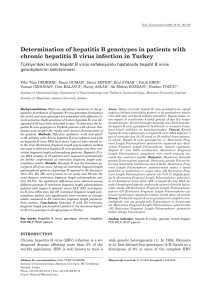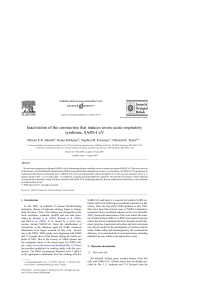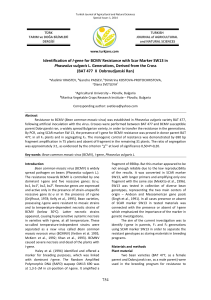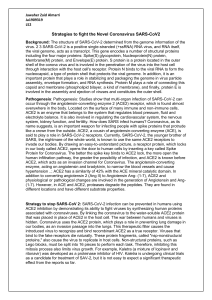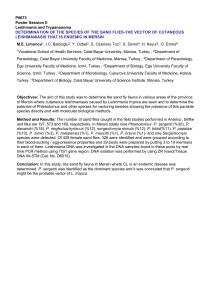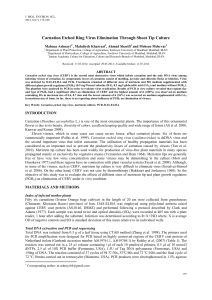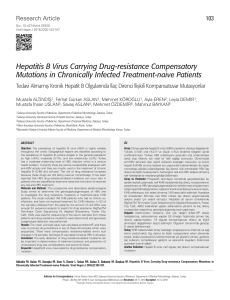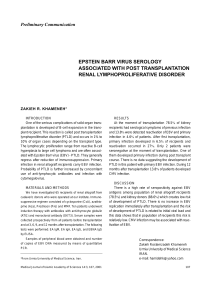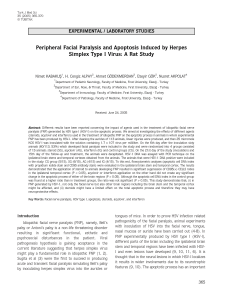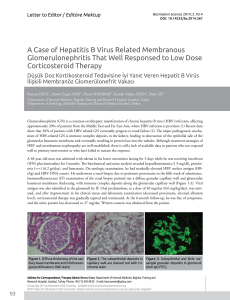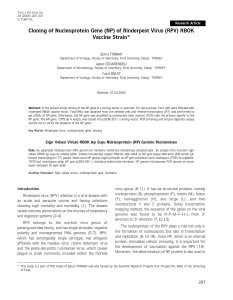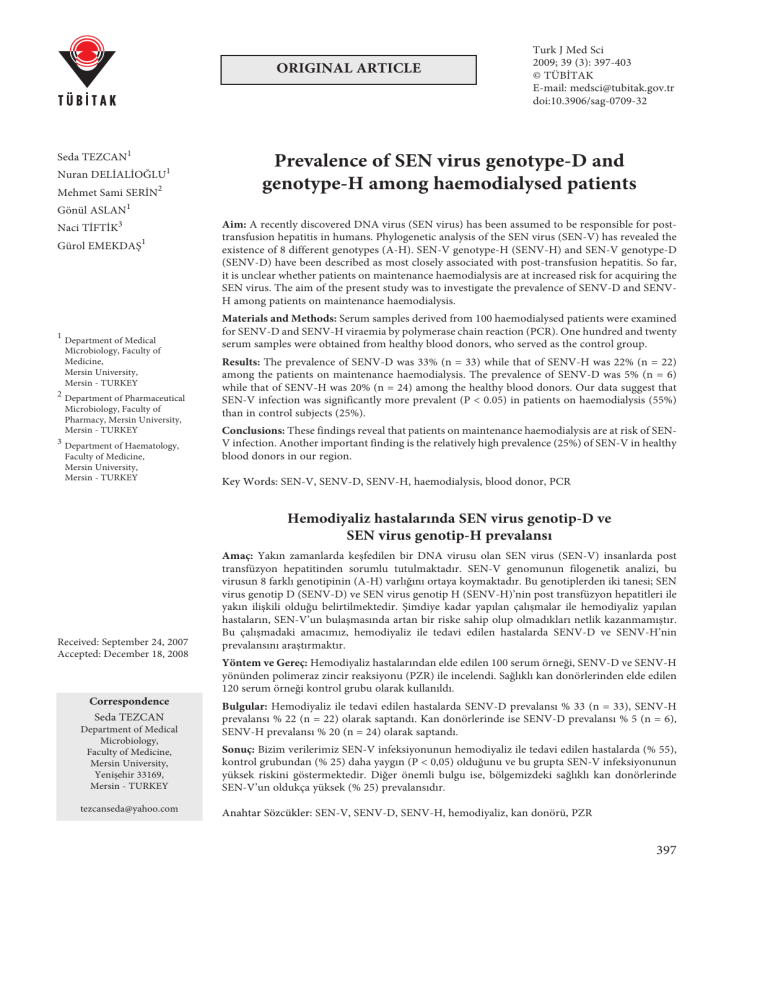
ORIGINAL ARTICLE
Seda TEZCAN1
Nuran DELİALİOĞLU1
Mehmet Sami SERİN2
Turk J Med Sci
2009; 39 (3): 397-403
© TÜBİTAK
E-mail: [email protected]
doi:10.3906/sag-0709-32
Prevalence of SEN virus genotype-D and
genotype-H among haemodialysed patients
Gönül ASLAN1
Naci TİFTİK3
1
Gürol EMEKDAŞ
1
2
3
Department of Medical
Microbiology, Faculty of
Medicine,
Mersin University,
Mersin - TURKEY
Department of Pharmaceutical
Microbiology, Faculty of
Pharmacy, Mersin University,
Mersin - TURKEY
Department of Haematology,
Faculty of Medicine,
Mersin University,
Mersin - TURKEY
Aim: A recently discovered DNA virus (SEN virus) has been assumed to be responsible for posttransfusion hepatitis in humans. Phylogenetic analysis of the SEN virus (SEN-V) has revealed the
existence of 8 different genotypes (A-H). SEN-V genotype-H (SENV-H) and SEN-V genotype-D
(SENV-D) have been described as most closely associated with post-transfusion hepatitis. So far,
it is unclear whether patients on maintenance haemodialysis are at increased risk for acquiring the
SEN virus. The aim of the present study was to investigate the prevalence of SENV-D and SENVH among patients on maintenance haemodialysis.
Materials and Methods: Serum samples derived from 100 haemodialysed patients were examined
for SENV-D and SENV-H viraemia by polymerase chain reaction (PCR). One hundred and twenty
serum samples were obtained from healthy blood donors, who served as the control group.
Results: The prevalence of SENV-D was 33% (n = 33) while that of SENV-H was 22% (n = 22)
among the patients on maintenance haemodialysis. The prevalence of SENV-D was 5% (n = 6)
while that of SENV-H was 20% (n = 24) among the healthy blood donors. Our data suggest that
SEN-V infection was significantly more prevalent (P < 0.05) in patients on haemodialysis (55%)
than in control subjects (25%).
Conclusions: These findings reveal that patients on maintenance haemodialysis are at risk of SENV infection. Another important finding is the relatively high prevalence (25%) of SEN-V in healthy
blood donors in our region.
Key Words: SEN-V, SENV-D, SENV-H, haemodialysis, blood donor, PCR
Hemodiyaliz hastalarında SEN virus genotip-D ve
SEN virus genotip-H prevalansı
Received: September 24, 2007
Accepted: December 18, 2008
Correspondence
Seda TEZCAN
Department of Medical
Microbiology,
Faculty of Medicine,
Mersin University,
Yenişehir 33169,
Mersin - TURKEY
[email protected]
Amaç: Yakın zamanlarda keşfedilen bir DNA virusu olan SEN virus (SEN-V) insanlarda post
transfüzyon hepatitinden sorumlu tutulmaktadır. SEN-V genomunun filogenetik analizi, bu
virusun 8 farklı genotipinin (A-H) varlığını ortaya koymaktadır. Bu genotiplerden iki tanesi; SEN
virus genotip D (SENV-D) ve SEN virus genotip H (SENV-H)’nin post transfüzyon hepatitleri ile
yakın ilişkili olduğu belirtilmektedir. Şimdiye kadar yapılan çalışmalar ile hemodiyaliz yapılan
hastaların, SEN-V’un bulaşmasında artan bir riske sahip olup olmadıkları netlik kazanmamıştır.
Bu çalışmadaki amacımız, hemodiyaliz ile tedavi edilen hastalarda SENV-D ve SENV-H’nin
prevalansını araştırmaktır.
Yöntem ve Gereç: Hemodiyaliz hastalarından elde edilen 100 serum örneği, SENV-D ve SENV-H
yönünden polimeraz zincir reaksiyonu (PZR) ile incelendi. Sağlıklı kan donörlerinden elde edilen
120 serum örneği kontrol grubu olarak kullanıldı.
Bulgular: Hemodiyaliz ile tedavi edilen hastalarda SENV-D prevalansı % 33 (n = 33), SENV-H
prevalansı % 22 (n = 22) olarak saptandı. Kan donörlerinde ise SENV-D prevalansı % 5 (n = 6),
SENV-H prevalansı % 20 (n = 24) olarak saptandı.
Sonuç: Bizim verilerimiz SEN-V infeksiyonunun hemodiyaliz ile tedavi edilen hastalarda (% 55),
kontrol grubundan (% 25) daha yaygın (P < 0,05) olduğunu ve bu grupta SEN-V infeksiyonunun
yüksek riskini göstermektedir. Diğer önemli bulgu ise, bölgemizdeki sağlıklı kan donörlerinde
SEN-V’un oldukça yüksek (% 25) prevalansıdır.
Anahtar Sözcükler: SEN-V, SENV-D, SENV-H, hemodiyaliz, kan donörü, PZR
397
TEZCAN, S et al.
SEN virus prevalence
Introduction
Five hepatitis viruses (A-E) have been established
for viral hepatitis cases and there are still patients
with acute or chronic hepatitis with unknown origin
(non-A to -E hepatitis) (1). Both the hepatitis-G
virus (HGV) and the TT virus (TTV) have been
indicated as candidates for new hepatitis viruses.
However, previous detailed investigations regarding
each of these viruses have shown that they are not a
significant causative agent of transfusion associated
non-A to -E hepatitis (1,2).
Recently, a new virus was discovered that might
be the primary cause of non-A to -E hepatitis. This
virus is named SEN, which was formed from the
initials of the patient from whom it was recovered in
the serum, an intravenous drug abuser infected with
human immunodeficiency virus (HIV) (3,4). The
SEN virus (SEN-V) is a member of the family
Circoviridae, a group of non-enveloped, circular
DNA viruses (4-6) that also include the recently
identified TTV and its variants SANBAN,
YONBAN, TUS01, and PMV. However, further
studies revealed that this virus is distantly related to
the TTV family (6).
The SEN-V genome is a single stranded DNA
and approximately 3800 nucleotides in length (4,5).
To date, phylogenetic analysis of SEN-V has
demonstrated 8 different genotypes: SENV-A to
SENV-H (2,7). SENV-D and SENV-H genotypes are
related to transfusion-associated non-A to -E
hepatitis (7) and are more prevalent within the
population exposed to transfusion (8). Nevertheless,
these genotypes have been found at various rates in
different populations and the role of SEN-V
regarding of the pathogenesis of liver disease is not
yet known (9,10).
Active infection is frequent in healthy blood
donors and in the general population. This high
prevalence is only explained by some SEN-V strains;
especially SENV-B, SENV-A, and SENV-E are less
frequently found among blood donors and do not
appear to be related to non-A to -E hepatitis (6,11).
In contrast, genotypes-D and -H have only been
found in 1% of blood donors but in more than 50%
of non-A to -E hepatitis cases. Chronic infection is
detected in patients with various hepatic diseases
398
Turk J Med Sci
(11). Despite the favourable ratio of donors/acute
hepatitis for SEN-V genotype-D and -H (the fact
that preliminary data suggest that SEN-V can
replicate in the liver), no true association between
SEN-V and liver damage has been proven so far (7).
Little is known of the natural history of the infection.
Chronic infections of over a decade have been
observed in retrospectively tested samples of
infected individuals, but most patients clear
viraemia during the first months of exposure.
Therefore, true exposure to the virus is difficult to
assess, as no serological test for SEN-V antibodies is
currently available (11).
SEN-V is transmitted by blood, as demonstrated
by comparing sequence homology between donor
and recipient (12). Moreover, transfused patients are
at higher risk of acquiring SEN-V than nontransfused patients. Risk of infection in transfused
patients increased proportionally with the number
of units of blood transfused (13). However, many
studies suggest that there is no association between
SEN-V and liver pathology. In our recent study,
SEN-V was detected at almost the same frequency in
patients with high alanine aminotransferase (ALT)
and aspartate aminotransferase (AST) levels but was
negative for HBV-DNA and HCV-RNA and
without any transfusion history and the control
group. Therefore, we had also suggested that SEN-V
does not seem to contribute to the pathogenesis of
liver disease (P > 0.05) (14). However, it is still
unclear whether these viruses are orphans.
Patients on maintenance haemodialysis are
considered to be at risk of infection by blood-borne
viruses, because the medical treatment processes are
frequently associated with intravenous drug
injection and blood transfusions (1). In this study,
we aimed to investigate the presence of SENV-D and
SENV-H genotypes in order to determine the
prevalence of SEN-V infection in patients on
maintenance haemodialysis and in healthy blood
donors in the city of Mersin, Turkey.
Materials and Methods
Serum samples and study populations
The serum samples were obtained from 100
patients on maintenance haemodialysis considered
Vol: 39
SEN virus prevalence
No: 3
to be at risk of blood-borne infections at a private
haemodialysis centre in Mersin in 2004. One
hundred and twenty serum samples were also
obtained from healthy volunteer blood donors as a
control group without a blood-borne contact history
and negative for routine donor screening tests at the
blood bank department of Mersin University
hospital. All serum samples were stored frozen at
–80 °C until analysis.
Viral DNA isolation
Viral DNA isolation was performed by extraction
of nucleic acid from serum samples. We used a
modified and optimized phenol-chloroform and
chloroform DNA extraction protocol from a
previously published procedure (15). Briefly, 100 μl
serum samples were mixed with 300 μl of lysis buffer
(13.3 mmol/l Tris-HCl [pH 8.0], 6.7 μmol/μl
ethylene-diamine-tetra-acetic acid, 0.67% sodium
dodecyl sulphate, and 133 mg/ml proteinase-K) and
incubated at 56 °C for 4 h. Two phenol-chloroform
extractions were followed by 1 chloroform
extraction, and DNA was precipitated with ethanol.
The DNA was eluted in 25 μl of DNase/RNase free
water. This was stored frozen at –20 °C until analysis
and used as a template for amplification.
Detection of SENV-D and SENV-H genotypes
Analysis of SENV-D and SENV-H genotypes was
performed by polymerase chain reaction (PCR) with
type-specific primers according to research articles
by Umemura et al. and Kojima et al. (7,16) with
several modifications. Primers D10S and L2AS and
primers C5S and L2AS were used for SENV-D and
SENV-H detections, respectively (Table 1). SENV-D
and SENV-H genotypes were analysed using the
same PCR conditions.
June 2009
PCR reactions for amplification of each sample
were carried out in a 50 μl PCR mixture containing
PCR buffer, 0.25 μmol/μl of nucleotide mix
(Promega, Madison, WI, USA), 0.2 μM of each
primer, 2.5 μmol/μl magnesium chloride, 1.75 U
Taq polymerase (Promega), and 10 μl of sample
DNA as template. The sample was amplified in a
thermal cycler (Eppendorf, Mastercycler, Germany).
The amplification protocol consisted of 5 min of
pre-denaturing at 94 °C, followed by 40 cycles of 1
min at 94 °C, 1 min at 60 °C, and 1 min 72 °C, and
then by a final extension at 70 °C for 10 min. The
products (222 base pairs [bp] for SENV-D and 229
bp for SENV-H) of PCR were separated using 2%
agarose gel, stained with ethidium bromide, and
visualised under a UV illuminator.
Statistical analysis
Differences between the groups were examined
by the 2 proportion comparison method using
MINTAB 13.0 software. P values < 0.05 were
considered significant.
Results
SENV-D was detected in 33 of the 100 (33%)
patients by genotype-specific PCR with genotype Dspecific primers. With the genotype H-specific
primers, SENV-H was detected in 22 (22%) of the
100 patients. In the control group, SENV-D was
detected in 6 (5%) and SENV-H was detected in 24
(20%) of the 120 blood donors (Table 2). The
genotypes were determined by size comparison of
the PCR products with DNA marker (Figure).
There were also significant differences for SEN-V
cases between the patient and control groups.
Table 1. Primers used to detect SEN-V.*
Sense primer (Sequence)
Antisense primer (Sequence)
Region Amplified (nt.)
D10S (5’-GTAACTTTGCGGTCAACTGCC-3’)
L2AS(5’-CCTCGGTTKSAAAKGTYTGATAGT-3’)
1322-1544a
C5S (5’-GGTGCCCCTWGTYAGTTGGCGGTT-3’)
L2AS(5’-CCTCGGTTKSAAAKGTYTGATAGT-3’)
1271-1500b
W: A or T, Y: C or T, M: A or C, K: G or T, S: C or G
a
b
Obtained from the sequence of SENV-D (AX025730)
Obtained from the sequence of SENV-H (AX025838)
* These data were taken from the research article by Kojima et al. (16)
399
SEN virus prevalence
TEZCAN, S et al.
Turk J Med Sci
Table 2. Prevalence of SEN-V infections in patient and control groups.
Study groups
Total (no.)
SEN-V positive
no. (%)
SENV-D positive
no. (%)
SENV-H positive
no. (%)
Patient group
Control group
100
120
55 (55)
30 (25)
33 (33)
6 (5)
22 (22)
24 (20)
500 bp
400 bp
300 bp
200 bp
100 bp
Figure. PCR products of SENV-D and SENV-H on 2% agarose gel. Lane 1; 100 bp DNA
step ladder (Promega), lane 2 and 3; 229 bp PCR product of SENV-H DNA, lane
4; SENV-H DNA negative sera sample, lane 5 and 6; 222 bp PCR product of
SENV-D DNA, lane 7; SENV-D DNA negative sera sample.
Although there were significant differences for
SENV-D cases (P < 0.05), there were no significant
differences for SENV-H cases (P > 0.05) between the
patient and control groups.
Discussion
Initial studies of SEN-V genotypes were
organised by Dr. Primi in Diasorin Laboratory, Italy.
The prevalence of 5 SEN-V genotypes (A, B, H, D,
and E) and consensus sequence designed from total
SEN-V were measured in various patients and
donor populations. These studies demonstrated that
SENV-D and SENV-H were found in high
prevalences in transfusion associated non-A to -E
hepatitis. Therefore, systematic research on SENVD and SENV-H in transfused populations and
healthy blood donors has intensified (7). We
400
performed this study in order to investigate the
prevalence of SENV-D and SENV-H in serum of
patients on maintenance haemodialysis and healthy
donors as controls in Mersin.
The prevalence of SENV-D/H DNA was 55%
(SENV-D: 33% and SENV-H: 2%) and 25% (SENVD: 5% and SENV-H: 20%) among haemodialysed
patients and healthy blood donors, respectively.
SENV-D/H infection was found more frequently in
haemodialysed patients than in healthy blood
donors. We suggest that the high prevalence in this
group was probably associated with long-term
intravenous drug injection with contaminated
devices and contamination with infected blood
through the chambers of the haemodialysis
instruments. This higher frequency in the patient
group implies that great attention should be paid to
SEN-V transmission risk during haemodialysis as is
Vol: 39
No: 3
SEN virus prevalence
paid to other blood-borne viruses such as HBV,
HCV, and HIV. It was reported that haemodialysed
patients are considered to be at risk of blood-borne
infection and previous studies indicated a high
prevalence of transfusion-transmitted viral agents
such as HCV, HGV, and TTV (17,18).
The prevalence of SENV-D/H was detected as
38% by Kobayashi et al., in Japan, as 68% by Kao et
al., in northern Taiwan, and as 61.6% by Dai et al., in
southern Taiwan, among haemodialysed patients
(1,19,20). The prevalence of SENV-H was reported
as 12.8% among maintenance haemodialysis in
Germany and as 16.8% among healthy blood donors
by Schröter et al. Because of no significant
differences for SENV-H cases between patient and
control groups, they reported that it was not
necessary to dialyse SENV-H viraemic patients on
separate machines (21). Our results also
demonstrated that the rate of SENV-H viraemia was
similar among patient (22%) and control groups
(20%) in our region. In any event, Schröter et al.
previously suggested that SENV-H might be
establishing a commensal relationship with its host,
resembling TTV in SENV-H viraemic individuals
(22). Therefore, both groups of our samples could
also be examined for TTV.
In Turkey, the prevalence of SENV-D and
SENV-H in patients on maintenance haemodialysis
was previously reported as 10.1% and as 16.8%,
respectively by Toraman et al., in Elazığ province
(23). According to our data, the prevalence was not
similar to that in different regions of Turkey.
However, the higher rate of SEN-V in our results
indicates a similarity with Taiwanese haemodialysed
patients (19,20). These results indicate that SEN-V
has a different geographic distribution and is fairly
common around the world.
Another interesting finding is the relatively high
prevalence (25%) of SENV-D/H viraemia (SENV-D:
5% and SENV-H: 20%) in healthy blood donors,
which implies that it is widespread among the
general population in our region. On the other hand,
many other studies report that the frequency of
SENV-D/H is high among healthy individuals;
SENV-D/H prevalence was reported as 15% (19),
24.2% (24), and 51% (25) by various researchers in
June 2009
Taiwan. Moreover, SENV-D/H prevalence was
detected as 10% (26) and 28.6% (27) in Japan, 2-3%
in Italy and America (7), and 39% (28) in Canada.
Our results are similar to the findings reported by
Dai et al. in Taiwan (24.2%) (24) but higher than
those reported by Shibata et al. in Japan (10%) (26),
by Kao et al. in Taiwan (15%) (19), and in Italy and
America (2-3%) (7). Clearly its prevalence have been
found to vary in different populations and
geographic regions. Therefore, this virus is seen as
endemic in the exposed area. These findings suggest
that this virus is probably transmitted by other
parenteral routes. Indeed, recent data suggest that
SENV-D/H could be transmitted by both parenteral
and non-parenteral routes and that its transmission
pattern might differ from that of HCV and HGV,
but is similar to that of TTV (10).
The rate of SENV-H viraemia in our study was
also higher than the findings reported by Schröter et
al. (21) and Toraman et al. (23). However, this could
be related to the sensitivity and specificity of the
primers we used. We have chosen the primers from
the research articles by Umemura et al. and Kojima
et al. (7,16). Kojima et al. (16) have reported the
sensitivity and specificity of the genotype specific
primers to be both 100% for SENV-D. However,
while the sensitivity was 100%, the specificity was
64% for SENV-H. These findings suggest that
confirmation by hybridization or sequencing could
be done for genotype-H. Therefore, our results for
genotype-H might need confirmation.
It was reported that the prevalence of SENV-D/H
infection after transfusion was 30%, while the
prevalence of SENV-D and SENV-H was 32.7% and
37.5%, respectively, in the United States (7,29).
Another study also reported that the prevalence of
SENV-D and SENV-H viraemia was 10.3% and
35.6% in a transfused population, respectively, in the
United States (3). SENV-D/H prevalence was
reported as 44.4% in Germany (22). All of these data
suggest that SEN-V transmission via blood could be
important during transfusion from infected donors.
However, there is no routine donor screening test
performed for SEN-V in the blood bank. Although
SEN-V has not been associated with liver disease, it
might be quite important if this novel virus is
401
TEZCAN, S et al.
SEN virus prevalence
associated with a pathology other than liver disease
in the future.
In conclusion, many healthy people are infected
with SEN-V in our region. Probably, primary
exposure occurs with this virus not only via the
parenteral route, but also by some other routes such
as the faecal-oral route in our region. Further studies
are still required in order to determine the
transmission routes of this novel virus. SEN-V
infection among haemodialysed patients at risk
Turk J Med Sci
group for transfusion-transmitted disease is
significantly higher than among healthy blood
donors. These findings indicate that more attention
should be paid during haemodialysis.
Acknowledgements
We would like to thank the members of Rennin
private haemodialysis centre for their cooperation
and help while collecting serum samples from the
patients.
References
1.
Kobayashi N, Tanaka E, Umemura T, Matsumoto A, Iijima T,
Higuchi M et al. Clinical significance of SEN virus infection in
patients on maintenance haemodialysis. Nephrol Dial
Transplant 2003; 18: 348-352.
12.
Ball JK, Curran R, Berridge S, Grabowska AM, Jameson CL,
Thomson BJ et al. TT virus sequence heterogeneity in vivo:
evidence for co-infection with multiple genetic types. J Gen
Virol 1999; 80: 1759-1768.
2.
Sagir A, Kirschberg O, Heintges T, Erhardt A, Haussinger D.
SEN virus infection. Rev Med Virol 2004; 14: 141-148.
13.
3.
Pfeiffer RM, Tanaka Y, Yeo AE, Umemura T, Seal KH, Shih
JW et al. Prevalence of SEN viruses among injection drug
users in the San Francisco Bay area. J Infect Dis 2003; 188: 1318.
Davidson F, MacDonald D, Mokili JLK, Prescott LE, Graham
S, Simmonds P. Early acquisition of TT virus (TTV) in an area
endemic for TTV infection. J Infec Dis 1999; 179: 1070-1076.
14.
Serin MS, Koksal F, Oksuz M, Abayli B, Aslan G, Tezcan S et
al. SEN virus prevalence among non-B and non-C hepatitis
patients with high liver function tests in the south of Turkey.
Jpn J Infect Dis 2005; 58: 349-352.
15.
Sambrook J, Fritsch EF, Maniatis T. Molecular Cloning: A
Laboratory Manual Book 3, 2nd ed. New York Cold Spring
Harbor Laboratory Press; 1989.
16.
Kojima H, Kaita KD, Zhang M, Giulivi A, Minuk GY.
Genomic analysis of a recently identified virus (SEN virus)
and genotypes -D and -H by polymerase chain reaction.
Antiviral Res 2003; 60: 27-33.
17.
Yu ML, Chuang WL, Wang LY, Dai CY, Chiou SS, Sung MH
et al. Status and natural course of GB virus C/hepatitis G virus
infection among high-risk groups and volunteer blood donors
in Taiwan. J Gastroenterol Hepatol 2000; 15: 1404-1410.
18.
Dai CY, Yu ML, Chuang WL, Sung MH, Lin ZY, Chen SC et
al. Epidemiology and clinical significance of chronic hepatitisrelated viruses infection in hemodialysis patients from
Taiwan. Nephron 2002; 90: 148-153.
19.
Kao JH, Chen W, Chen PJ, Lai MY, Chen DS. Prevalence and
implication of a newly identified infectious agent (SEN virus)
in Taiwan. J Infect Dis 2002; 185: 389-392.
20.
Dai CY, Chuang WL, Chang WY, Chen SC, Sung MH, Hsieh
MY et al. SEN virus infection among patients on maintenance
hemodialysis in southern Taiwan. J Infect 2005; 51: 110-115.
21.
Schroter M, Laufs R, Zollner B, Knodler B, Schafer P, Feucht
HH. A novel DNA virus (SEN) among patients on
maintenance hemodialysis: prevalence and clinical
importance. J Clin Virol 2003; 27: 69-73.
4.
Sugiura T, Goto K, Imamine H, Ando T, Ban K, Sugiyama K
et al. Prevalence of SEN virus among children in Japan. Virus
Res 2004; 100: 223-228.
5.
Bowden S. New hepatitis viruses: contenders and pretenders.
J Gastroenterol Hepatol 2001; 16: 124-131.
6.
Tanaka Y, Primi D, Wang RYH, Umemura T, Yeo AET,
Mizokami M et al. Genomic and evolutionary analysis of a
newly identified infectious agent (SEN virus) and its
relationship to the TT virus family. J Infec Dis 2001; 183: 359367.
7.
Umemura T, Yeo AE, Sottini A, Moratto D, Tanaka Y, Wang
RYH et al. SEN virus infection and its relationship to
transfusion-associated hepatitis. Hepatology 2001; 33: 13031311.
8.
Mushahwar IK. Recently discovered blood-borne viruses: are
they hepatitis viruses or merely endosymbionts? J Med Virol
2000; 62: 399-404.
9.
Lin JG, Goto T, Nakane K, Miura K, Mikami K, Ohshima S et
al. Clinical significance of SEN-virus on interferon response
in chronic hepatitis C patients. J Gastroenterol Hepatol 2003;
18: 1144-1149.
10.
11.
402
Umemura T, Alter HJ, Tanaka E, Yeo AE, Shih JW, Orii K et
al. Association between SEN virus infection and hepatitis C in
Japan. J Infect Dis 2001; 184: 1246-1251.
Allain JP, Thomas I, Sauleda S. Nucleic acid testing for
emerging viral infections. Transfus Med 2002; 12: 275-283.
Vol: 39
No: 3
SEN virus prevalence
June 2009
22.
Schroter M, Laufs R, Zollner B, Knodler B, Schafer P, Sterneck
M et al. Prevalence of SENV-H viraemia among healthy
subjects and individuals at risk for parenterally transmitted
diseases in Germany. J Viral Hepat 2002; 9: 455-459.
26.
Shibata M, Wang RY, Yoshiba M, Shih JW, Alter HJ,
Mitamura K. The presence of a newly identified infectious
agent (SEN virus) in patients with liver diseases and in blood
donors in Japan. J Infect Dis 2001; 184: 400-404.
23.
Toraman ZA, Bulut Y, Aksoy A, Özdarendeli A, Seyrek A.
Prevalence of SENV-D and SENV-H on maintenance
haemodialysis patients. 3rd National Molecular and
Diagnostic Microbiology Congress, 28 June-1 July, Ankara,
Turkey. Program and announcement abstract book; 2004. p.
216.
27.
Mikuni M, Moriyama M, Tanaka N, Abe K, Arakawa Y. SEN
virus infection does not affect the progression of non-A to -E
liver disease. J Med Virol 2002; 67: 624-629.
28.
Wong SG, Primi D, Kojima H, Sottini A, Giulivi A, Zhang M
et al. Insights into SEN virus prevalence, transmission, and
treatment in community-based persons and patients with
liver disease referred to a liver disease unit. Clin Infect Dis
2002; 35: 789-795.
29.
Wilson LE, Umemura T, Astemborski J, Ray SC, Alter HJ,
Strathdee SA et al. Dynamics of SEN virus infection among
injection drug users. J Infect Dis 2001; 184: 1315-1319.
24.
25.
Dai CY, Yu ML, Lin ZY, Chen SC, Hsieh MY, Wang LY et al.
Prevalence and clinical significance of SEN virus infection
among volunteer blood donors in southern Taiwan. Dig Dis
Sci 2004; 49: 1181-1185.
Huang LR, Wang HH, Lin WS, Lin CL. The prevalence of SEN
virus infection in blood donors in Taiwan. J Infect 2005; 51:
30-34.
403

